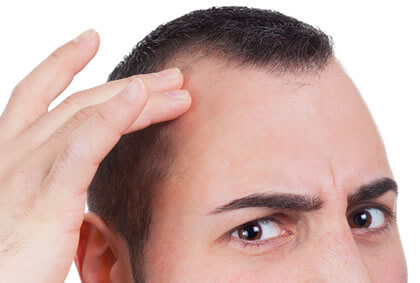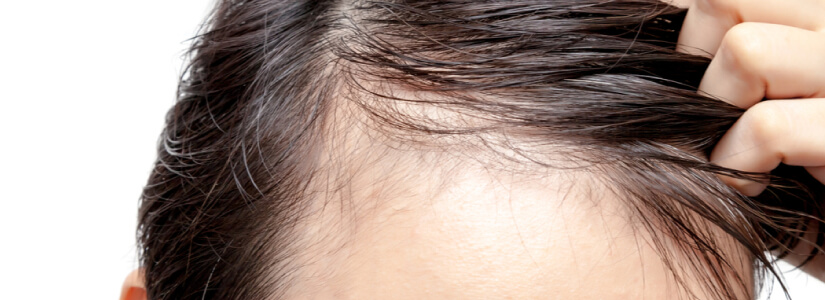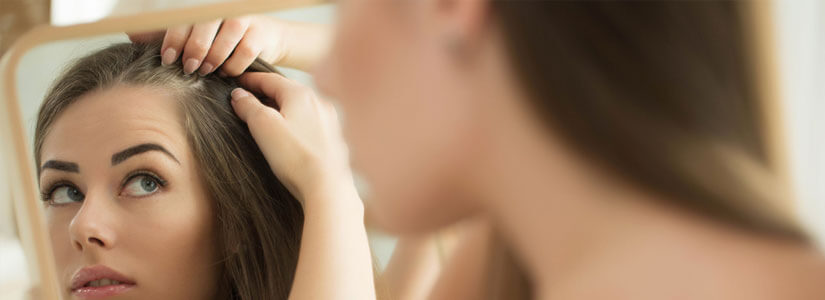How To Stop A Receding Hairline And Regrow Hair?
September 8, 2018

Are you struggling with baldness along the frontal hairline? Is receding hairline becoming the nightmare that gives you sleepless nights? Worry not! Receded hairline problem is very much treatable. Frontal baldness is most commonly observed in men than women, but it still remains a cause of concern for both sexes. There are a number of invasive and non-invasive treatment options available to help you stop hair loss in the frontal hairline and regrow hairs. But to decide the right course of treatment for your receding hairline it is important that you determine what causes baldness along the frontal hairline in your case.
There are numerous factors that act alone or in combination to cause baldness along frontal hairline. Excessive hair loss is the primary cause of hairline recession, but you need to figure out what exactly is causing hair your hair to fall out. Finding out the underlying cause behind frontal baldness can help in treating the condition. Listed below are some most common causes of baldness along the frontal hairline:
This is the most common cause of receded hairline in men. Caused by increased levels of Dihydrotestosterone, androgenic alopecia affects up to 70% of the men around the globe. Dihydrotestosterone attacks the hair follicles causing them to shrink to an extent where they permanently lose their ability to grow hair. This drastically reduces hair growth, resulting in hair thinning all over and almost no hair in the temples, frontal region and crown area. So, if your hair loss is exhibiting this particular pattern, you are most probably suffering from androgenic alopecia.
Sometimes your genes are the culprit behind hair thinning between the temples. Tendency to go bald runs in families and no side of family (maternal or paternal) can be blamed more. Genetic hair loss is mostly hormonal. Androgen is a male hormone that is converted into Dihydrotestosterone through action of enzyme 5 alpha reductase. This enzyme action on androgens is stronger in families where people inherit balding genes and as a result more and more hair follicles become miniaturized, causing grave hair loss problems.
DHT is not the only cause of receded hairline and baldness. Stress is also a key contributor to hair loss problem. Both physical and emotional stress can lead to increased hair shedding. People often experience severe hair loss after undergoing some emotionally traumatic situation like breakup, bereavement or bankruptcy. Sudden illness and surgery can also lead to increased hair shedding. Even childbirth can lead to hair loss. If not controlled in time, this hair loss can become severe and permanent causing baldness along frontal hairline and in the crown area.
While Dihydrotestosterone is the main culprit behind hair loss problems, there are numerous other hormones as well that can trigger hair loss in both men and women. Estrogen, the female reproductive hormone is responsible for hair growth in women. Low levels of estrogen in women can lead to receding hairline. Testosterone has a similar impact on hair growth in men.
Age is one of the major contributors of baldness. Some experience just a recession in frontal hairline while others end up with a completely bald thatch. According to the National Institute of Health (US), baldness along hairline is common in older people with over 60% of men suffering from receded hairline at some stage in their lives, and about 25% of them start shedding hair as early as in their late 20s or early 30s.
Certain ailments can trigger and accelerate hair loss. At the top of the list is androgenic alopecia. Other diseases that are often associated with cause hair loss in the frontal region include the following:
Fungal infections can also cause excessive hair loss. Seborrheic dermatitis – a skin condition in which scalp becomes overly oily or dry – is the most common type of skin infection that triggers hair loss in both men and women. Other scalp infections that can cause severe hair loss include eczema, acne, dandruff and sebaceous cysts.
Some drugs have been known to cause significant hair loss in both males and females. Medicines that can trigger hair loss include drugs prescribed for treating high blood pressure, cardiovascular diseases, cholesterol and gout problems. Certain Anti-depressants have also been found to accelerate hair loss. Drugs rich in Vitamin A can also trigger hair loss. There are certain medical treatments as well that cause temporary hair loss, and at the top of the list is chemotherapy – the only known treatment for cancer. If you have already a recessing hairline, undergoing chemotherapy may worsen the situation. But the good news is that it is temporary and hairs grow back as soon as the treatment is discontinued.
While hair loss is considered to be a permanent and uncontrollable phenomenon, by following a healthy hair care regimen, you can not only prevent hair loss but also reverse its symptoms.
If you have any queries or want to know more about frontal baldness and its treatments, feel free to contact Hair Transplant Dubai Clinic now. We also offer free online consultations. To book an appointment now, fill the form below.
Dr. Cagatay Sezgin is a celebrity hair transplant surgeon with over 20 years of experience in hair transplantation and restoration. He is the First Turkish Board Surgeon to become a member of the International Society of Hair Restoration Surgery (ISHRS) and the Asian Association of Hair Transplant Surgeons (AAHRS). Moreover, he has the honor of becoming the first hair transplant surgeon in the world to perform hair, eyebrow, and beard transplantation all in one case and that too in a single session.

September 8, 2018

November 20, 2018

December 29, 2015